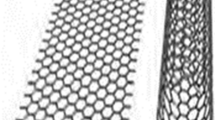Abstract
Carbon nanotubes are attractive for switching applications since electrostatically-actuated CNT switches have low actuation voltages and power requirements, while allowing GHz switching speeds that stem from the inherently high elastic modulus and low mass of the CNT. Our first NEM structure, the air-bridge switch, consists of suspended single-walled nanotubes (SWNTs) that lie above a sputtered Nb electrode. Electrical measurements of these air-bridge devices show well-defined ON and OFF states as a dc bias of a few volts is applied. The switches were measured to have switching times down to a few nanoseconds. Our second NEM structure, the vertical CNT switch, consists of nanotubes grown perpendicular to the substrate. Vertical multi-walled nanotubes (MWNTs) are grown directly on a heavily doped Si substrate, from 200 – 300 nm wide, ~ 1 µm deep nano-pockets, with Nb metal electrodes to result in the formation of a vertical single-pole-double-throw CNT switch architecture.
Similar content being viewed by others
References
P. Kim and C. M. Lieber, Science 286, 2148 (1999).
T. Rueckes, K. Kim, E. Joselevich, G. Y. Tseng, C. L. Cheung, and C. M. Lieber, Science 289, 94 (2000).
P. G. Collins, K. B. Bradley, M. Ishigamo, and A. Zettl, Science 287, 120 (2000).
V. Sazonova, Y. Yaish, H. Ustunel, D. Roundy, T. A. Arias, and P. L. McEuen, Nature 431, 284 (2004).
M. Dequesnes, S. V. Rotkin and N. R. Aluru, Nanotech. 13, 120 (2002).
B. M. Segal, D. K. Block, R. Thomas, Electromechanical memory array using nanotubes ribbons and method for making same, US Patent 6, 919, 592, 2004.
J. M. Kinaret, T. Nord, and S. Viefers, Appl. Phys. Lett., 82, 1287 (2003).
S. W. Lee, D. S. Lee, R. E. Morjan, S. H. Jhang, M. Sveningsson, O. A. Nerushev, Y. W. Park, and E. E. B. Campbell, Nano. Lett. 4, 2027 (2004).
S. N. Cha, J. E. Jang, Y. Choi, and G. A. J. Amaratunga, D. J. Kang, D. J. Hasko, J. E. Jung and J. M. Kim, Appl. Phys. Lett. 86, 083105-1 (2005).
E. Dujardin, V. Derycke, M. F. Goffman, R. Lefevre, and J. P. Bourgoin, Appl. Phys. Lett. 87, 193107-1 (2005).
A. B. Kaul, E. W. Wong, L. Epp, and B. D. Hunt, accepted, to appear in Nano Letters, April 2006.
D. Peroulis, S. P. Pacheco, K. Sarabandi, L. P. B. Katehi, IEEE Trans. on Microwave Theory and Tech. 51, 259 (2003).
S. Duffy, et al., IEEE Microwave Wireless Comp. Lett. 11, 106 (2001).
Author information
Authors and Affiliations
Rights and permissions
About this article
Cite this article
Kaul, A.B., Wong, E.W., Epp, L. et al. Air Bridge and Vertical Carbon Nanotube Switches for High Performance Switching Applications. MRS Online Proceedings Library 924, 604 (2006). https://doi.org/10.1557/PROC-0924-Z06-04
Received:
Accepted:
Published:
DOI: https://doi.org/10.1557/PROC-0924-Z06-04




